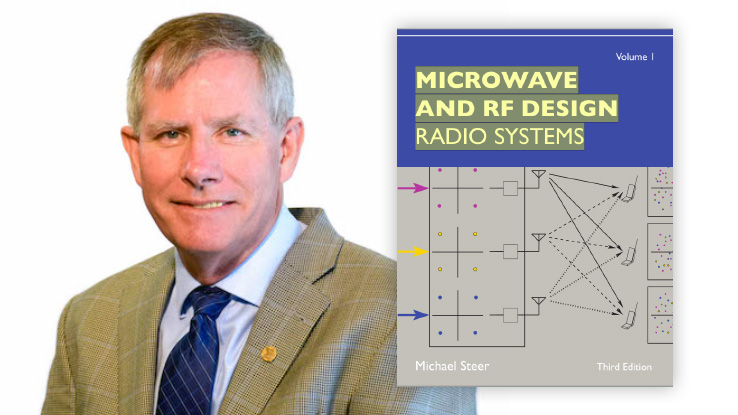
The power of the “open textbook”

Your publisher doesn’t want to print your textbook anymore. You can’t do anything about the pirated copies out there on the web. Most academic authors would be pretty upset. But Michael Steer saw this as an opportunity. And he reached out to the Libraries about making his book an open textbook.
Steer is a Distinguished Professor of Electrical and Computer Engineering at NC State and a prolific author in his field. A Fellow of the Institute of Electrical and Electronics Engineers (IEEE) and a former editor-in-chief of IEEE Transactions on Microwave Theory and Techniques, Steer has authored more than 500 publications including twelve books.
Chief among his titles is the multi-volume textbook Microwave and RF Design, which has become an industry standard, suitable as both an undergraduate and graduate textbook, as well as a career-long reference book. The textbook provides a circuits- and systems-oriented approach to the fundamental materials required to gain entry to radio frequency and microwave design.
But the textbook industry isn’t student-friendly. Search for Steer’s title and you’ll find print copies with price tags of over $100 for each volume in the series. And yet the publisher’s profit margin for the title has been shrinking—dig a little deeper and you can find pirated copies, in varying states of completeness and correctness, too. So the publisher didn’t want to continue printing Steer’s books.
After Steer got the copyright back from his publisher last year, he approached the Libraries to discuss open textbook options. He worked with Open Knowledge Librarian Micah Vandegrift to turn Microwave and RF Design into an open textbook, with NC State University as the publisher. It’s now available through UNC Press, free from the Libraries’ open textbook repository, as well as through the Open Textbook Library, a national, open repository of free, peer-reviewed, openly-licensed textbooks. The Open Textbook Library currently has almost 700 titles, and it’s growing fast.
“I’ve been emailing other academics in my field [about my book], and the feedback has been incredible,” Steer says. “Putting something in open access—most people think that is tremendous. Students will, and academics will too. I mean, most academics are under tremendous pressure to do something about textbook costs. Even though textbooks are just a small part of the whole tuition package, it’s got oversized importance. So having an open access textbook is just a tremendous relief.”
The Libraries is a nationally recognized leader in OERs—open educational resources. In 2014, the Libraries started its Alt-Textbook Program, which awards grants to faculty to adopt, adapt, or create free or low-cost alternatives to expensive textbooks, saving NC State students more than $250,000 in its first year. Since then, the program has become a nationally recognized leader in supporting teaching and learning that is both more equitable, more effective, and often innovative.
Recently, the Libraries has partnered with Distance Education and Learning Technology Applications (DELTA) and Wolfpack Outfitters (the campus bookstore) to award Open Textbook Grants to faculty, created the Open Textbook Toolkit to provide simple, flexible, scalable components for OER adoptions, partnered with NC LIVE on the Open Education North Carolina (OENC) initiative to offer a comprehensive suite of OER services and resources to educators across the entire state, and launched the Open Pedagogy Incubator to incentivize faculty to go beyond the simple creation of open course materials to a full implementation of multiple Open Pedagogy approaches such as student-created content in their courses.
The Libraries is all about open education, and Steer is completely on board.
Now that Microwave and RF Design is an open textbook, Steer thinks it will find a much wider usage than ever before. “The first print edition was used in 40 universities,” he says. “And I expect that, with open access, it will be used in many hundreds.”
As soon as he got his copyright back, Steer knew he wanted to move his books to open access, but his connection with the Libraries really made it happen. Not only did the Libraries provide him with the services that publishers do—such as getting an ISBN, managing online formatting issues like font control, and providing necessary funding—its academic imprint gave Steer’s book the legitimacy that self-publishing wouldn’t have. And he expects his colleagues to jump on the “open” bandwagon soon.
“I came here in 1983, so I’ve been here 36 years,” he notes. “NC State is much greater than its reputation, and I want NC State to really stand out. We have a special and very loyal group of faculty here. What I’m hoping is that we can start other faculty doing open textbooks, and many of them have approached me about it. They need a lot of help. We need help editing, and we need someone like Micah too.”
“If there are no commercial enterprises publishing textbooks in the future, how is the next generation—or even just the next five years—going to learn without them?” Steer asks. “It’s going to be open access textbooks. We’re fighting for our academic survival, for the ability to teach relevant things in our classrooms. The way to do it is not through the commercial publishers. It has to happen through the open access model.”
For more information, please visit this new project page for Dr. Steer's textbook.